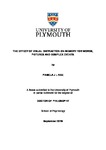The effect of visual distraction on memory for words, pictures and complex events
| dc.contributor.supervisor | Hollins, Timothy J | |
| dc.contributor.author | Rae, Pamela J L | |
| dc.contributor.other | Faculty of Health | en_US |
| dc.date.accessioned | 2019-09-02T09:03:50Z | |
| dc.date.available | 2019-09-02T09:03:50Z | |
| dc.date.issued | 2019 | |
| dc.identifier | 10079687 | en_US |
| dc.identifier.uri | http://hdl.handle.net/10026.1/14850 | |
| dc.description.abstract |
This thesis aims to provide further understanding of how visual distraction disrupts retrieval from long-term memory. Eyewitness testimony research shows a fairly consistent picture: visual distraction (or its removal though eye-closure) decreases retrieval-accuracy of details embedded in an event. However, research on verbal memory suggest that distraction effects may be selective: Glenberg, Schroeder and Robertson’s (1998) widely cited study found distraction to impair recall of mid-list words from multiple word-lists but Rae’s (2011) single word-list studies found no such effect. The investigation thus began with a part-replication of Glenberg et al. with tighter control of materials including using Dynamic Visual Noise (DVN) as a distraction. Experiment 1 replicated the findings on mid-list recall. Experiments 2 and 3 investigated whether the effect on mid-list words was due to poor encoding or interference however, found no detrimental effect of distraction on word-recall whatsoever. Experiment 4 confirmed that DVN does impair retrieval accuracy for an event. Therefore, the focus of the thesis moved to exploring whether distraction selectively impairs cognitive processes involved in event but not word-list retrieval. Experiments 5 and 6 manipulated Experiment 4’s event so that the original video-clip became more like a list. Together with the serial presentation of details in Experiments 7 and 8, these studies explored four possible moderators of distraction: modality of detail; bimodal presentation; source monitoring; flowing movement. A meta-analysis of effect sizes showed visual distraction to have stronger detrimental effects on recall of flowing visual details. This is explained by both the Cognitive Resources Framework (Vredeveldt, 2011) and Event Segmentation Theory (Zacks & Swallow, 2007) which together imply that visual distraction may disrupt memory by selectively impairing visual-spatial imagery. | en_US |
| dc.language.iso | en | |
| dc.publisher | University of Plymouth | |
| dc.subject | Visual distraction | en_US |
| dc.subject | Memory | en_US |
| dc.subject | Embodied memory | en_US |
| dc.subject | Dynamic visual noise | en_US |
| dc.subject | Word-list recall | en_US |
| dc.subject | Event recall | en_US |
| dc.subject | Episodic memory | en_US |
| dc.subject.classification | PhD | en_US |
| dc.title | The effect of visual distraction on memory for words, pictures and complex events | en_US |
| dc.type | Thesis | |
| plymouth.version | publishable | en_US |
| dc.identifier.doi | http://dx.doi.org/10.24382/946 | |
| dc.rights.embargoperiod | No embargo | en_US |
| dc.type.qualification | Doctorate | en_US |
| rioxxterms.version | NA | |
| plymouth.orcid.id | http://orcid.org/0000-0003-0370-6570 | en_US |
Files in this item
This item appears in the following Collection(s)
-
01 Research Theses Main Collection
Research Theses Main


